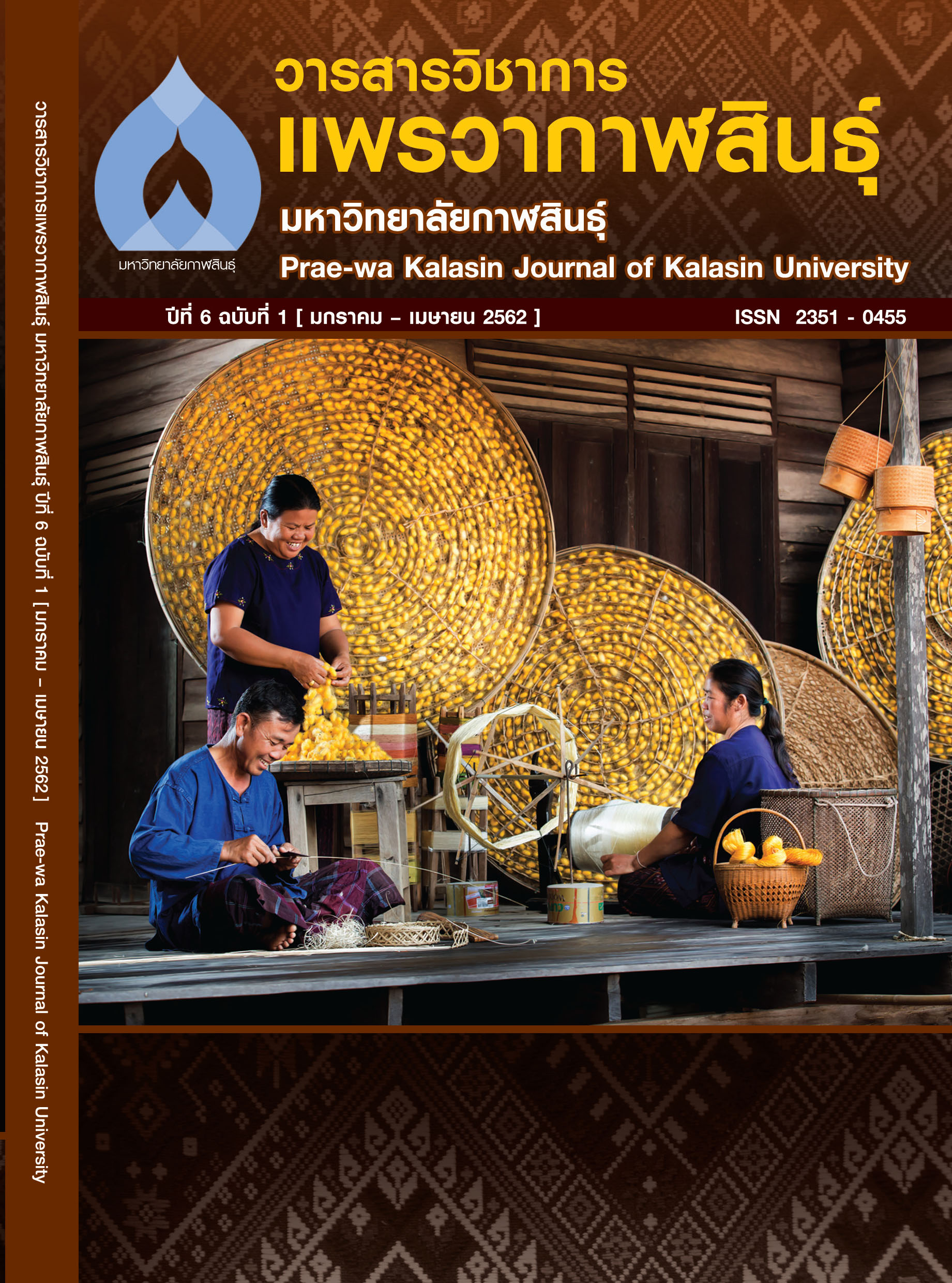STEM Education with Learning Management
Main Article Content
Abstract
The development of science, technology influenced in educational change. All levels emphasized on their’ higher order thinking skills, as well as developing students’ communication skills using technology as a tool for inquiry and acquisition of social skills. Integration of all subjects and learning, both in classroom and real life, Learning good Inevitably cause learning well. The teacher is a person who has a role in the students learning. Teachers with the knowledge and skills, is the primary trend in education to make learning meaningful to students. As a result, students would realize the value of their studies and could apply their knowledge to their everyday life and their continuing study, which would enlarge more job opportunity in the future, add more value, and build more national economy.
Article Details
References
Klomim, Kamolchart. (2016). Learning Management Based on STEM Education for Student Teachers. Journal of Education Naresuan University, 18(4).
ขวัญใจ เชิดชู. (2557). นวัตกรรมทางการศึกษา STEM Education. สืบค้นเมื่อ 15 ตุลาคม 2556. จาก http://kwanjaicherdchoo.blogspot.com/2014_09_01 archive.html
Cherdchoo, Kwanjai. (2014). Educational InnovationSTEM Education. Retrieved September 15, 2016, from http://kwanjaicherdchoo. blogspot.com/2014_09_01_archive.html
ทรูปลูกปัญญา. (2557). ปั้นข้าวจี่ ฝีมือหนู. สืบค้นเมื่อ 25 กันยายน 2559 จากhttp://www.trueplookpanya.com/new/cms_detail/news/19493
Trueplookpanya. (2557). Pun khao jee Fee mu nu. Retrieved September 25, 2016, from http://www.trueplookpanya.com/new/cms_detail/news/19493
พรทิพย์ ศิริภัทราชัย. (2556). STEM Education กับการพัฒนาทักษะในศตวรรษที่ 21. วารสารนักบริหาร, 33(2).
Siriphatthachai, Porntip. (2013). STEM Education and 21st Century Skills Development. Executive Journal, 33(2).
พลศักดิ์ แสงพรมศร. (2558). การเปรียบเทียบผลสัมฤทธ์ทางการเรียน ทักษะกระบวนการทางวิทยาศาสตร์ขั้นสูงและเจตคติต่อการเรียนเคมีของนักเรียนชั้นมัธยมศึกษาปีที่ 5 ที่ได้รับการจัดการเรียนรู้สะเต็มศึกษากับแบบปกติ. วารสารศึกษาศาสตร์มหาสารคาม. 9 (ฉบับพิเศษ).
Sangpomsorn, Pollasuk. (2015). Comparisons of learning achievement, integrated science process skills, and attitude towards chemistry learning for Matthayomsueksa 5 students between STEM education and conventional methods. Journal of Education, Mahasarakham University, 9(Special Edition).
รักษพล ธนานุวงศ์. (2556ก). รายงานสรุปการประชุมเชิงปฏิบัติการ STEM Education. สืบค้นเมื่อ 15 ตุลาคม 2556 จาก http://www.slideshare.net/focusphysics/stemworkshopsummary
Thananuwong, Ruksapol. (2013a). Report Workshop of STEM Education. Retrieved September 15, 2013, from http://www.slideshare.net/focusphysics/stemworkshopsummary
รักษพล ธนานุวงศ์. (2556ข). เรียนรู้สภาวะโลกร้อนด้วย STEM Education แบบบูรณาการ. สถาบันส่งเสริมการสอนวิทยาศาสตร์และเทคโนโลยี (สสวท.), 41(182).
Thananuwong, Raksapol.(2556ข). Learning Global Warming by integration STEM Education. The institute for the Promotion of Teaching Science and Technology. 41(182).
วารุณี หนองห้าง. (2553). ทักษะการคิดพื้นฐานวิชาภาษาอังกฤษของนักเรียนชั้นมัธยมศึกษาปีที่ 1 โรงเรียนหนองห้างพิทยา จังหวัดกาฬสินธุ์ที่ได้รับการจัดการเรียนร้โู ดยใช้รูปแบบการสอนเพื่อให้เกิดมโนมติของ บรูเนอร์. (การศึกษาค้นคว้าอิสระ, มหาวิทยาลัยขอนแก่น). วิชัย ประสิทธ์วุฒิเวชช์ (2542). การพัฒนาหลักสูตรสานต่อที่ท้องถิ่น. กรุงเทพฯ: เลิฟแอนด์ลิพ เพรส.
Prasitwutthiwat, Wichai. (1999). The curriculum development the local on carry. Bangkok: loveandlip press
ศูนย์สะเต็มศึกษาแห่งชาติ. (2558). คู่มือเครือข่ายสะเต็มศึกษา. กรุงเทพฯ: สถาบันส่งเสริมการสอนวิทยาศาสตร์ และเทคโนโลยี, กระทรวงศึกษาธิการ.
National STEM Education Center. (2015). Manual network STEM Education. Bangkok: The Institute for the Promotion of Teaching Science and Technology. Ministry of Education. (in Thai)
สุมาลี ชัยเจริญ. (2557). การออกแบบการสอน หลักการ ทฤษฎี สู่การปฏิบัติ. ขอนแก่น: มหาวิทยาลัยขอนแก่น.
Sumalee Chaijaroen. (2008). Instructional design: Principles and theories to practice. Khon Kaen : KhonKaen University.
สุมน อมรวิวัฒน์ (2533). สมบัติทิพย์ของการศึกษาไทย. กรุงเทพฯ: จุฬาลงกรณ์มหาวิทยาลัย. Sumul Amornwiwat. (2533).
Breiner, J.M., Carla, C.J., Harkness, S. S., & Koehler, C.M. (2012). “What is STEM? A discussion about conceptions of STEM in education and Shelly Sheats Harkness Partnerships”. School Science and Mathematics, 112 (1).
Dejarnette. (2012). “America’s children: providing early exposure to STEM (science, technology, engineering and math) initiatives”. Education, 133(1), 77-84.
Good, C.V. (1975). Dictionary of Education. New York: McGraw- Hill Book.
Hills, P.J. A .(1982). Dictionary of Education. London: Routledge & Kegan Payi.
Hough,John B. and Duncan, Jam’es K. 1970. Teaching description and analysis. Addison-Westlu.
Jolly, A. (June 17, 2014). Six characteristics of a great STEM lesson. Education Week Teacher, Retrieved September 19, 2016, from http://www.edweek.org/tm/articles/2014/06/17/ctq_ jolly_stem.html?intc=mvs%20
Lantz, H. B. (2009). Sicence, Technology, Engineering, and Mathematics (STEM) Education What Form? What Function?. Retrieved on March 12, 2014, from https://dornsife.usc.edu /assets/ sites/1/docs/jep/STEMEducationArticle.pdf
Todd R. Kelleyand J. Geoff Knowles. (2016).A conceptual framework for integrated STEM education. International Journal ofSTEM Education, Retrieved September 25, 2016, from https://stemeducationjournal. springeropen.com/articles/10.1186/s40594-016-0046-z
Vasquez, J. A., Snelder, C. & Comer, M. (2013). STEM Lesson Essentials: Grades 3-8.
Wayne, C. (2012). What is S.T.E.M. and why do I need to know?. Retrieved September 20, 2016, from https://issuu.com/carleygroup/docs/stem12online/1
